Chandan Singh
Shammie
Towards Understanding Graphical Perception in Large Multimodal Models
Mar 13, 2025Abstract:Despite the promising results of large multimodal models (LMMs) in complex vision-language tasks that require knowledge, reasoning, and perception abilities together, we surprisingly found that these models struggle with simple tasks on infographics that require perception only. As existing benchmarks primarily focus on end tasks that require various abilities, they provide limited, fine-grained insights into the limitations of the models' perception abilities. To address this gap, we leverage the theory of graphical perception, an approach used to study how humans decode visual information encoded on charts and graphs, to develop an evaluation framework for analyzing gaps in LMMs' perception abilities in charts. With automated task generation and response evaluation designs, our framework enables comprehensive and controlled testing of LMMs' graphical perception across diverse chart types, visual elements, and task types. We apply our framework to evaluate and diagnose the perception capabilities of state-of-the-art LMMs at three granularity levels (chart, visual element, and pixel). Our findings underscore several critical limitations of current state-of-the-art LMMs, including GPT-4o: their inability to (1) generalize across chart types, (2) understand fundamental visual elements, and (3) cross reference values within a chart. These insights provide guidance for future improvements in perception abilities of LMMs. The evaluation framework and labeled data are publicly available at https://github.com/microsoft/lmm-graphical-perception.
Interpretable Language Modeling via Induction-head Ngram Models
Oct 31, 2024


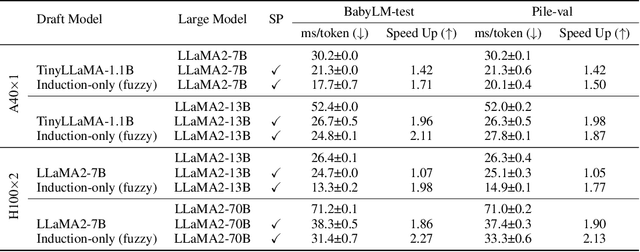
Abstract:Recent large language models (LLMs) have excelled across a wide range of tasks, but their use in high-stakes and compute-limited settings has intensified the demand for interpretability and efficiency. We address this need by proposing Induction-head ngram models (Induction-Gram), a method that builds an efficient, interpretable LM by bolstering modern ngram models with a hand-engineered "induction head". This induction head uses a custom neural similarity metric to efficiently search the model's input context for potential next-word completions. This process enables Induction-Gram to provide ngram-level grounding for each generated token. Moreover, experiments show that this simple method significantly improves next-word prediction over baseline interpretable models (up to 26%p) and can be used to speed up LLM inference for large models through speculative decoding. We further study Induction-Gram in a natural-language neuroscience setting, where the goal is to predict the next fMRI response in a sequence. It again provides a significant improvement over interpretable models (20% relative increase in the correlation of predicted fMRI responses), potentially enabling deeper scientific investigation of language selectivity in the brain. The code is available at https://github.com/ejkim47/induction-gram.
Bayesian Concept Bottleneck Models with LLM Priors
Oct 21, 2024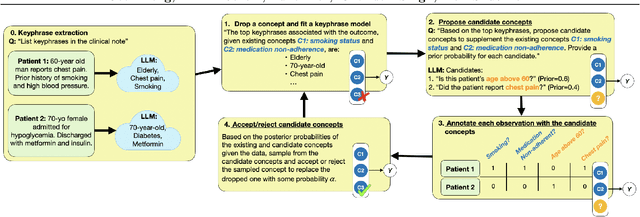

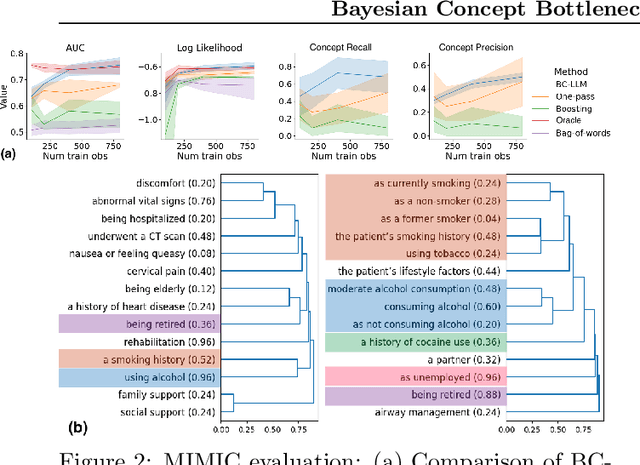
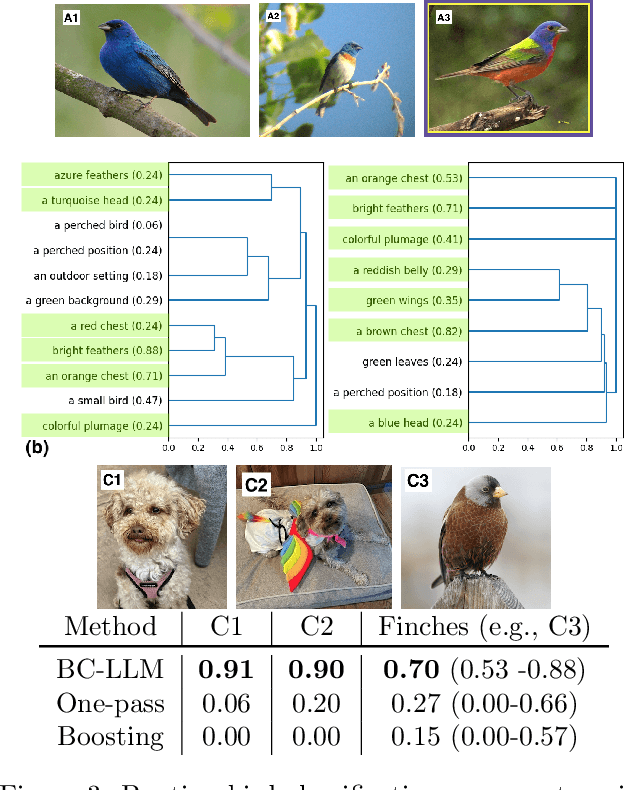
Abstract:Concept Bottleneck Models (CBMs) have been proposed as a compromise between white-box and black-box models, aiming to achieve interpretability without sacrificing accuracy. The standard training procedure for CBMs is to predefine a candidate set of human-interpretable concepts, extract their values from the training data, and identify a sparse subset as inputs to a transparent prediction model. However, such approaches are often hampered by the tradeoff between enumerating a sufficiently large set of concepts to include those that are truly relevant versus controlling the cost of obtaining concept extractions. This work investigates a novel approach that sidesteps these challenges: BC-LLM iteratively searches over a potentially infinite set of concepts within a Bayesian framework, in which Large Language Models (LLMs) serve as both a concept extraction mechanism and prior. BC-LLM is broadly applicable and multi-modal. Despite imperfections in LLMs, we prove that BC-LLM can provide rigorous statistical inference and uncertainty quantification. In experiments, it outperforms comparator methods including black-box models, converges more rapidly towards relevant concepts and away from spuriously correlated ones, and is more robust to out-of-distribution samples.
Vector-ICL: In-context Learning with Continuous Vector Representations
Oct 08, 2024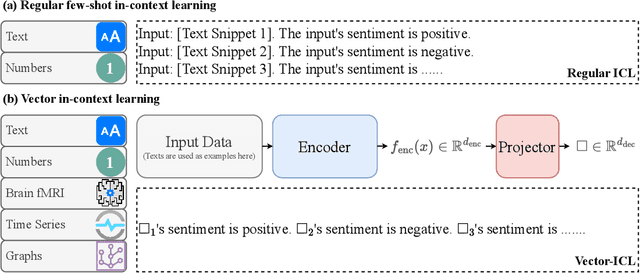
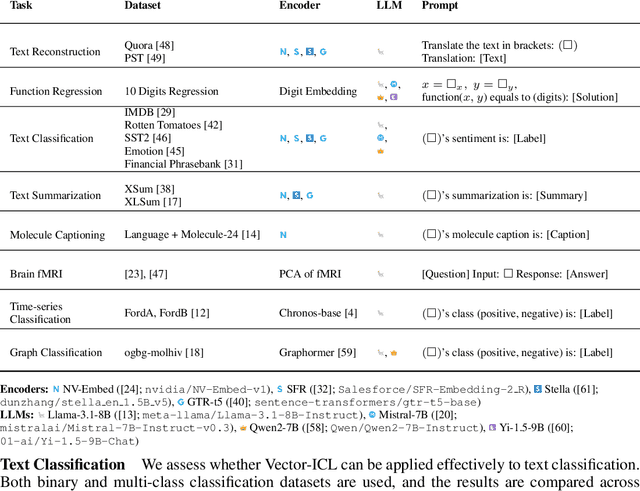


Abstract:Large language models (LLMs) have shown remarkable in-context learning (ICL) capabilities on textual data. We explore whether these capabilities can be extended to continuous vectors from diverse domains, obtained from black-box pretrained encoders. By aligning input data with an LLM's embedding space through lightweight projectors, we observe that LLMs can effectively process and learn from these projected vectors, which we term Vector-ICL. In particular, we find that pretraining projectors with general language modeling objectives enables Vector-ICL, while task-specific finetuning further enhances performance. In our experiments across various tasks and modalities, including text reconstruction, numerical function regression, text classification, summarization, molecule captioning, time-series classification, graph classification, and fMRI decoding, Vector-ICL often surpasses both few-shot ICL and domain-specific model or tuning. We further conduct analyses and case studies, indicating the potential of LLMs to process vector representations beyond traditional token-based paradigms.
A generative framework to bridge data-driven models and scientific theories in language neuroscience
Oct 01, 2024


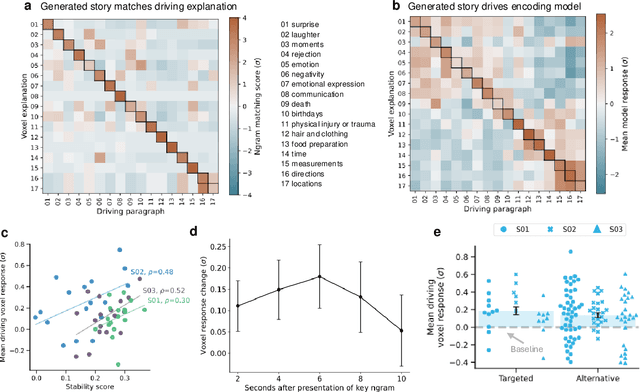
Abstract:Representations from large language models are highly effective at predicting BOLD fMRI responses to language stimuli. However, these representations are largely opaque: it is unclear what features of the language stimulus drive the response in each brain area. We present generative explanation-mediated validation, a framework for generating concise explanations of language selectivity in the brain and then validating those explanations in follow-up experiments that use synthetic stimuli. This approach is successful at explaining selectivity both in individual voxels and cortical regions of interest (ROIs).We show that explanatory accuracy is closely related to the predictive power and stability of the underlying statistical models. These results demonstrate that LLMs can be used to bridge the widening gap between data-driven models and formal scientific theories.
Model Tells Itself Where to Attend: Faithfulness Meets Automatic Attention Steering
Sep 16, 2024



Abstract:Large language models (LLMs) have demonstrated remarkable performance across various real-world tasks. However, they often struggle to fully comprehend and effectively utilize their input contexts, resulting in responses that are unfaithful or hallucinated. This difficulty increases for contexts that are long or contain distracting information, which can divert LLMs from fully capturing essential evidence. To address this issue, many works use prompting to help LLMs utilize contextual information more faithfully. For instance, iterative prompting highlights key information in two steps that first ask the LLM to identify important pieces of context and then derive answers accordingly. However, prompting methods are constrained to highlighting key information implicitly in token space, which is often insufficient to fully steer the model's attention. To improve model faithfulness more reliably, we propose AutoPASTA, a method that automatically identifies key contextual information and explicitly highlights it by steering an LLM's attention scores. Like prompting, AutoPASTA is applied at inference time and does not require changing any model parameters. Our experiments on open-book QA demonstrate that AutoPASTA effectively enables models to grasp essential contextual information, leading to substantially improved model faithfulness and performance, e.g., an average improvement of 7.95% for LLAMA3-70B-Instruct. Code will be publicly available at https://github.com/QingruZhang/AutoPASTA .
Crafting Interpretable Embeddings by Asking LLMs Questions
May 26, 2024Abstract:Large language models (LLMs) have rapidly improved text embeddings for a growing array of natural-language processing tasks. However, their opaqueness and proliferation into scientific domains such as neuroscience have created a growing need for interpretability. Here, we ask whether we can obtain interpretable embeddings through LLM prompting. We introduce question-answering embeddings (QA-Emb), embeddings where each feature represents an answer to a yes/no question asked to an LLM. Training QA-Emb reduces to selecting a set of underlying questions rather than learning model weights. We use QA-Emb to flexibly generate interpretable models for predicting fMRI voxel responses to language stimuli. QA-Emb significantly outperforms an established interpretable baseline, and does so while requiring very few questions. This paves the way towards building flexible feature spaces that can concretize and evaluate our understanding of semantic brain representations. We additionally find that QA-Emb can be effectively approximated with an efficient model, and we explore broader applications in simple NLP tasks.
Attribute Structuring Improves LLM-Based Evaluation of Clinical Text Summaries
Mar 01, 2024



Abstract:Summarizing clinical text is crucial in health decision-support and clinical research. Large language models (LLMs) have shown the potential to generate accurate clinical text summaries, but still struggle with issues regarding grounding and evaluation, especially in safety-critical domains such as health. Holistically evaluating text summaries is challenging because they may contain unsubstantiated information. Here, we explore a general mitigation framework using Attribute Structuring (AS), which structures the summary evaluation process. It decomposes the evaluation process into a grounded procedure that uses an LLM for relatively simple structuring and scoring tasks, rather than the full task of holistic summary evaluation. Experiments show that AS consistently improves the correspondence between human annotations and automated metrics in clinical text summarization. Additionally, AS yields interpretations in the form of a short text span corresponding to each output, which enables efficient human auditing, paving the way towards trustworthy evaluation of clinical information in resource-constrained scenarios. We release our code, prompts, and an open-source benchmark at https://github.com/microsoft/attribute-structuring.
Learning a Decision Tree Algorithm with Transformers
Feb 06, 2024Abstract:Decision trees are renowned for their interpretability capability to achieve high predictive performance, especially on tabular data. Traditionally, they are constructed through recursive algorithms, where they partition the data at every node in a tree. However, identifying the best partition is challenging, as decision trees optimized for local segments may not bring global generalization. To address this, we introduce MetaTree, which trains a transformer-based model on filtered outputs from classical algorithms to produce strong decision trees for classification. Specifically, we fit both greedy decision trees and optimized decision trees on a large number of datasets. We then train MetaTree to produce the trees that achieve strong generalization performance. This training enables MetaTree to not only emulate these algorithms, but also to intelligently adapt its strategy according to the context, thereby achieving superior generalization performance.
Rethinking Interpretability in the Era of Large Language Models
Jan 30, 2024

Abstract:Interpretable machine learning has exploded as an area of interest over the last decade, sparked by the rise of increasingly large datasets and deep neural networks. Simultaneously, large language models (LLMs) have demonstrated remarkable capabilities across a wide array of tasks, offering a chance to rethink opportunities in interpretable machine learning. Notably, the capability to explain in natural language allows LLMs to expand the scale and complexity of patterns that can be given to a human. However, these new capabilities raise new challenges, such as hallucinated explanations and immense computational costs. In this position paper, we start by reviewing existing methods to evaluate the emerging field of LLM interpretation (both interpreting LLMs and using LLMs for explanation). We contend that, despite their limitations, LLMs hold the opportunity to redefine interpretability with a more ambitious scope across many applications, including in auditing LLMs themselves. We highlight two emerging research priorities for LLM interpretation: using LLMs to directly analyze new datasets and to generate interactive explanations.
 Add to Chrome
Add to Chrome Add to Firefox
Add to Firefox Add to Edge
Add to Edge